While most Americans know about social media bots, many think they have a negative impact on how people stay informed
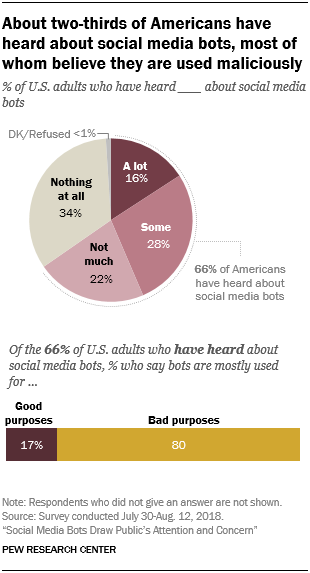
Since the 2016 U.S. presidential election, many Americans have expressed
concern about the presence of misinformation online, particularly on
social media. Recent
Congressional hearings and investigations by
social media sites and
academic researchers have suggested that one factor in the spread of misinformation is social media bots – accounts that operate on their own, without human involvement, to post and interact with others on social media sites.
This topic has drawn the attention of much of the public: About two-thirds of Americans (66%) have heard about social media bots, though far fewer (16%) have heard a lot about these accounts. Among those aware of the phenomenon, a large majority are concerned that bot accounts are being used maliciously, according to a new Pew Research Center survey conducted July 30-Aug. 12, 2018, among 4,581 U.S. adults who are members of Pew Research Center’s nationally representative American Trends Panel (the Center has previously
studied bots on Twitter and the
news sites to which they link). Eight-in-ten of those who have heard of bots say that these accounts are mostly used for bad purposes, while just 17% say they are mostly used for good purposes.
To further understand some of the nuances of the public’s views of social media bots, the remainder of this study explores attitudes among those Americans who have heard about them (about a third – 34% – have not heard anything about them).
While many Americans are aware of the existence of social media bots, fewer are confident they can identify them. About half of those who have heard about bots (47%) are very or somewhat confident they can recognize these accounts on social media, with just 7% saying they are very confident. In contrast, 84% of Americans expressed confidence in their ability to recognize made-up news in an earlier
study.

When it comes to the news environment specifically, many find social media bots’ presence pervasive and concerning. About eight-in-ten of those who have heard of bots (81%) think that at least a fair amount of the news people get from social media comes from these accounts, including 17% who think a great deal comes from bots. And about two-thirds (66%) think that social media bots have a mostly negative effect on how well-informed Americans are about current events, while far fewer (11%) believe they have a mostly positive effect.
While the public’s overall impression of social media bots is negative, they have more nuanced views about specific uses of these accounts – with some uses receiving overwhelming support or opposition. For example, 78% of those who have heard about bots support the government using them to post emergency updates, the most popular function of the nine asked about in the survey. In contrast, these Americans are overwhelmingly opposed to the use of bots to post made-up news or false information (92%). They are also largely opposed to bots being used for political purposes and are more split when considering how companies and news organizations often use bots.
Most Americans have heard about social media bots; many think they are malicious and hard to identify
By
Galen Stocking and
Nami Sumida
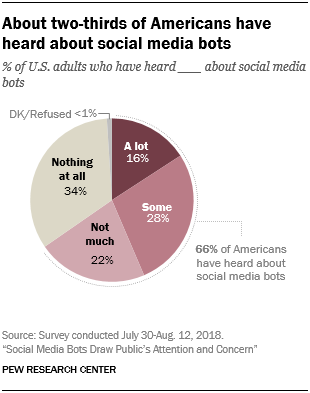
Amid the ongoing debate about the role of bots on social media, about two-thirds of Americans (66%) have heard at least something about social media bots – defined in this survey as accounts that operate “on their own, without human involvement, to post and do other activities on social media sites.” But very few pay close attention: Just 16% have heard a lot about social media bots. And roughly a third of the public (34%) has heard nothing at all about these types of accounts.
While most Americans have heard about them, the debate about social media bots has not reached all corners of the public at the same rate.

Younger Americans are much more likely than older adults to have heard about social media bots. About three-quarters of Americans ages 18 to 29 and 30 to 49 (78% and 76%, respectively) have heard of bots, compared with 58% of those ages 50 to 64 and about half of those 65 or older (49%). The same pattern holds when comparing how much they have heard, with younger Americans more likely than their elders to have heard a lot or some about bots.
There are also differences in familiarity by education and, to a lesser extent, by party affiliation. About three-quarters of Americans with a college degree (78%) have heard of social media bots, compared with 55% of those with only a high school education. In addition, Democrats and Democratic-leaning independents are more likely than Republicans and Republican-leaning independents to have heard about social media bots (72% vs. 61%, respectively).
Many see bad intentions behind social media bots and find them difficult to identify
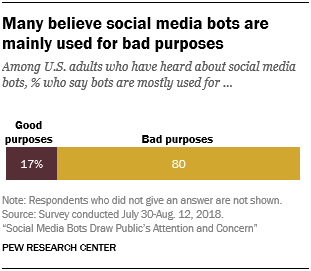
Amid the larger debate about misinformation and bots on social media, the public largely views bots negatively. An overwhelming majority of those who have heard of bots (80%) say that these accounts are mostly used for bad purposes, while just 17% say that bots are mostly used for good purposes.
This broad consensus is consistent across demographic groups. For instance, roughly eight-in-ten Republicans and Republican-leaning independents as well as Democrats and Democratic-leaning independents who have heard of bots suspect they are primarily used for malicious purposes (84% and 78%, respectively). Similarly, even though younger people are more likely to have heard of bots, there is broad agreement across age groups about their intended purpose: About eight-in-ten Americans in each age group who have heard about bots believe they are mostly used for malicious purposes.
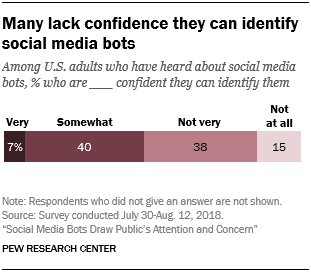
Not only does the public generally have a negative view of social media bots, but few Americans have a lot of confidence in their own ability to detect them. About half of those who have heard of bots (47%) are very or somewhat confident that they can recognize them, and just 7% are very confident. About four-in-ten (38%) are not very confident, and 15% say they are not at all confident. This stands in contrast to the confidence Americans had in their ability to detect made-up news: In a December 2016
survey, 84% of Americans were very or somewhat confident in their ability to recognize made-up news.
Younger Americans are more likely than older adults to be at least somewhat confident they can recognize social media bots. Six-in-ten adults ages 18 to 29 who have heard of these accounts are at least somewhat confident they can recognize them, compared with about half or less for older age groups.
Many believe at least some of the news on social media comes from bots and that these accounts have a negative impact on how the public stays informed
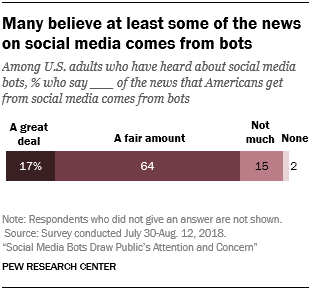
While social media bots can be used for many different purposes, much of the public discussion has been about their use in the
spread of news. The public seems to have taken notice, and many believe at least some of the news Americans get on social media comes from bots.
About eight-in-ten of those who have heard of bots (81%) think these accounts are responsible for at least a fair amount of the news Americans get on social media, though fewer (17%) think a great deal comes from bots. (A previous Pew Research Center
study of more than 100,000 tweeted links to 50 popular news websites found that 59% of those shared links were suspected to be from bots.)

And, just as Americans are concerned about bots generally, many in the public perceive bots’ involvement in the news to be negative, at least when it comes to how well-informed the public is about the news. About two-thirds of those who have heard about social media bots (66%) say that these accounts have a mostly negative effect on how well-informed Americans are about events and issues in the news. In contrast, only 11% believe bots have a mostly positive effect, and about two-in-ten (21%) say they do not have much of an effect.
What’s more, those who think bots are responsible for a sizable portion of the news on social media are also more likely to think bots have a negative impact on keeping the public informed. Among those who say at least a fair amount of news on social media comes from bots, about seven-in-ten (72%) say that bots negatively impact how well-informed Americans are about the news, compared with 11% who say bots have a positive impact and 17% who say they have no impact.
Not many differences emerge across demographic groups, with broad agreement that at least a fair amount of the news Americans see on social media comes from bots and that bots have a negative effect on how well-informed Americans are.
Americans express nuanced views of many common uses of social media bots
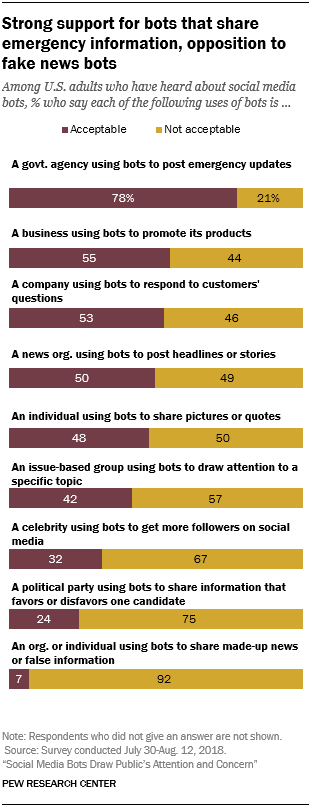
Although social media bots largely have a negative connotation among the public, certain uses of bots seem to be more acceptable than others. Those who have heard about bots were asked about a mix of nine ways that social media bots are used. Topping the list of supported uses: government agencies using bots to post emergency updates. About eight-in-ten of those who have heard about bots (78%) find this practice to be acceptable.
On the flip side, there is solid opposition to an organization or individual using bots to share false information, with 92% of those who have heard of bots saying this is not acceptable. Strong majorities also oppose a celebrity using bots to gain more social media followers (67%) and a political party using bots to share information that favors or disfavors one candidate (75%). When it comes to an issue-based group using bots for a political purpose – to draw attention to a specific topic – opposition is not as strong as to a political party using bots, though more people still find it unacceptable (57%) than acceptable (42%).
The public is more split for the remaining uses. At least half of those who have heard about social media bots find the two business-related uses acceptable: businesses using bots to promote products (55%) and respond to customers’ questions (53%). Similarly, the public is about evenly split on whether news organizations’ use of bots to post headlines or news stories is acceptable or not (50% find it acceptable and 49% find it unacceptable). And when it comes to an individual using bots to share pictures or quotes, about equal shares of those who have heard of bots find it acceptable (48%) as unacceptable (50%).
The more Americans know about bots, the less likely they are to find several of their uses to be acceptable

Americans who have heard more about social media bots are less likely to be supportive of a number of their uses.
This is true for the two politics-related uses. Those who have heard a lot about bots are 10-percentage points less likely than those who have heard some or not much about bots to say an issue-based group using bots to draw attention to a specific topic is acceptable (34% and 44%, respectively). Similarly, those who have heard a lot about bots are less supportive of a political party using bots to share information that favors or disfavors one candidate, compared with those who haven’t heard as much about bots (19% and 25%, respectively).
Awareness about social media bots also influences views on two uses that help people or organizations promote themselves. For instance, a business using bots to promote its products is considered acceptable by 45% of those who have heard a lot about bots, compared with 58% of those who have heard less about them – a 13-point gap. And there is a 9-point gap when it comes to a celebrity using bots to get more social media followers.
 Cristina y Massa evitan cualquier negociación antes de junio
Cristina y Massa evitan cualquier negociación antes de junio



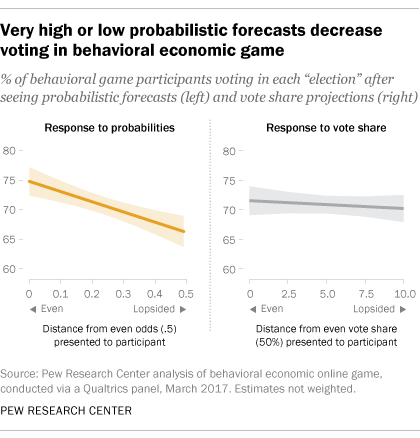
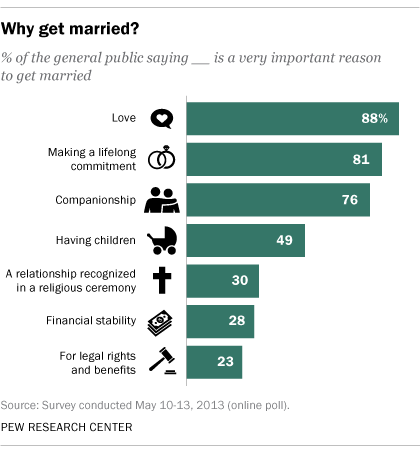
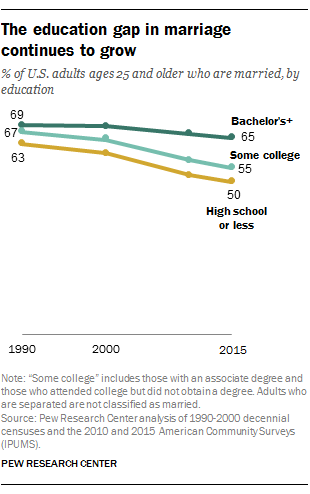
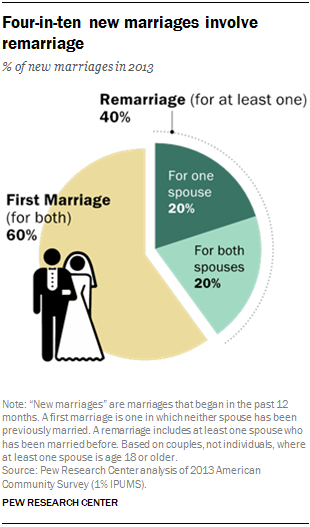
 One-in-six newlyweds (17%) were
One-in-six newlyweds (17%) were 
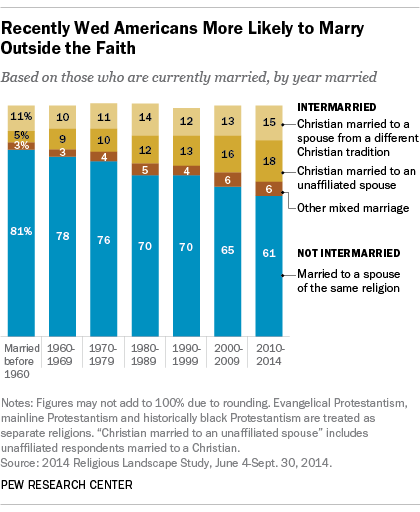

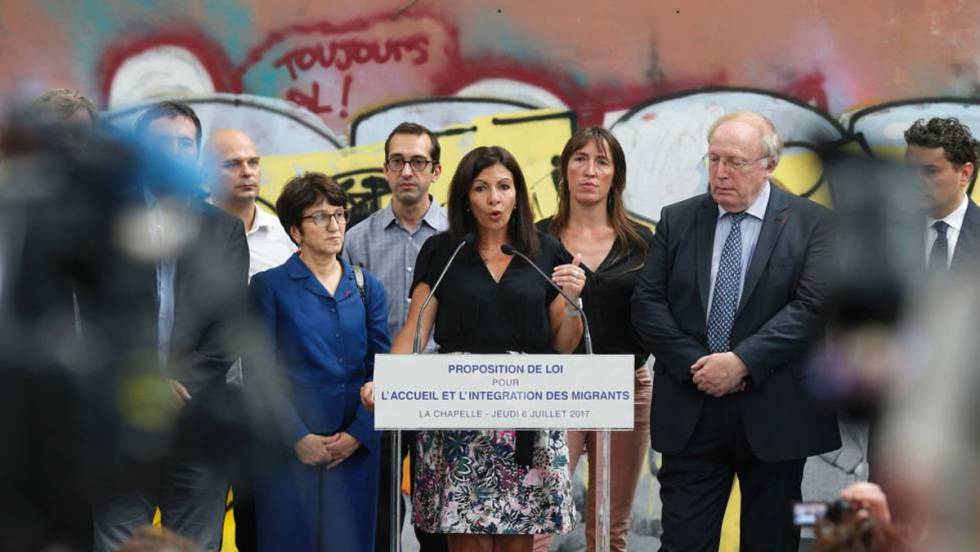 La alcaldesa de París, Anne Hidalgo, durante el lanzamiento del programa de acogida a los migrantes en un refugio en La Chapelle.
La alcaldesa de París, Anne Hidalgo, durante el lanzamiento del programa de acogida a los migrantes en un refugio en La Chapelle. 


















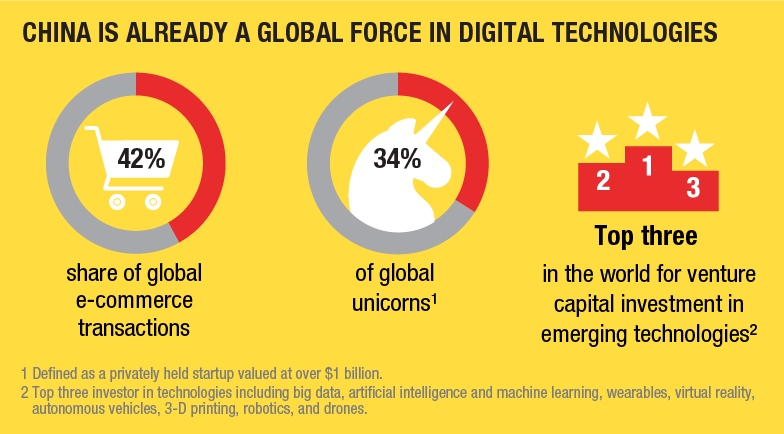
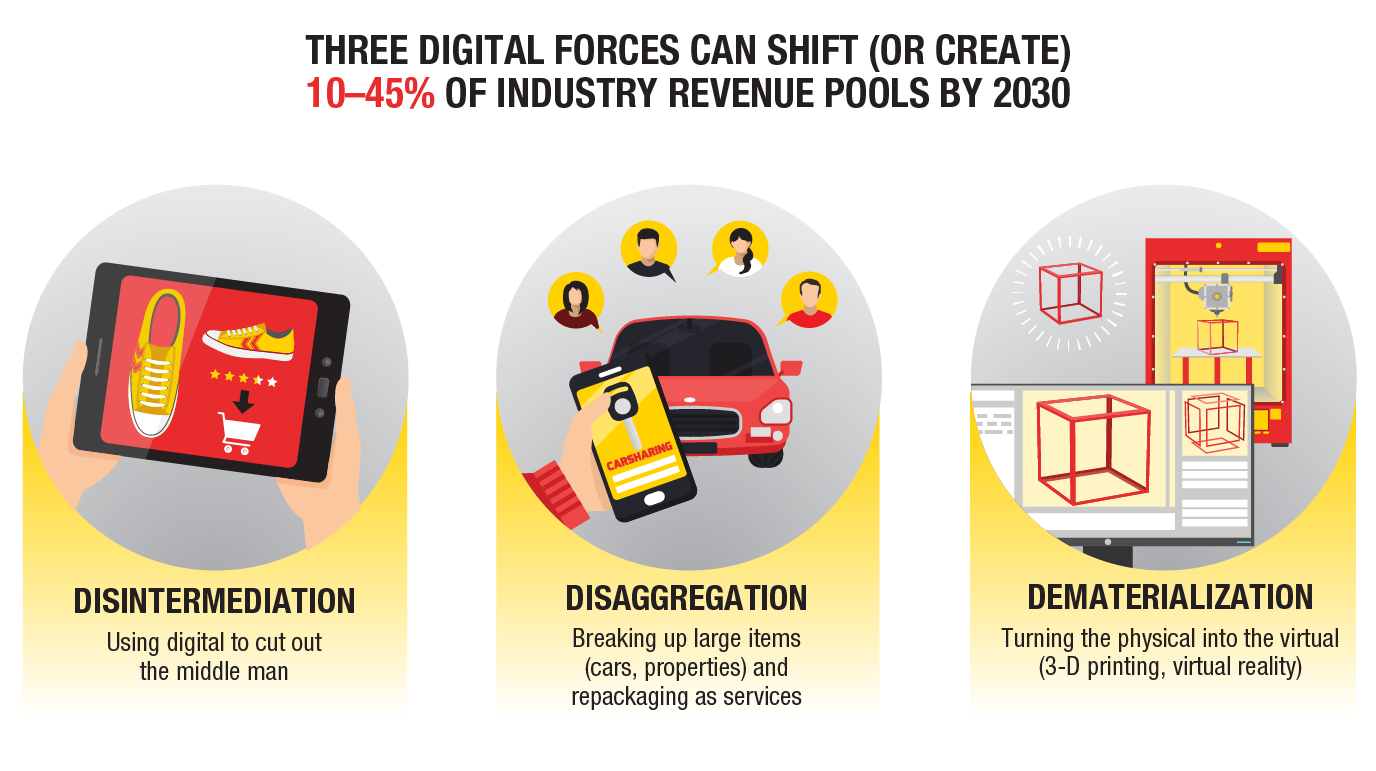

/s3.amazonaws.com/arc-wordpress-client-uploads/infobae-wp/wp-content/uploads/2019/01/10124757/planta-BGH-Tierra-del-fuego-1920-1.jpg) La planta de la empresa en Tierra del Fuego
La planta de la empresa en Tierra del Fuego/s3.amazonaws.com/arc-wordpress-client-uploads/infobae-wp/wp-content/uploads/2019/01/10124805/planta-BGH-Tierra-del-fuego-1920-2.jpg) En la Patagonia, BGH produce aires acondicionados, microondas y televisores
En la Patagonia, BGH produce aires acondicionados, microondas y televisores/s3.amazonaws.com/arc-wordpress-client-uploads/infobae-wp/wp-content/uploads/2019/02/11133751/fate-1.jpg) La fábrica de Fate en San Fernando
La fábrica de Fate en San Fernando

